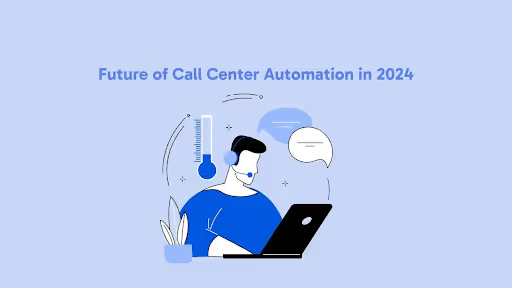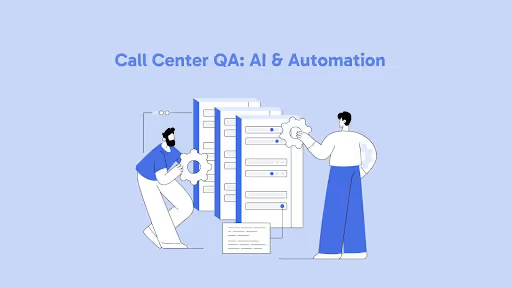Thanks to the power of automation, call centers are evolving faster than ever. It's all about giving customers a quicker, smoother experience and ensuring agents stay energized from handling repetitive queries. Automation in call centers is reshaping the industry, helping businesses deliver 24/7 support without the constant overhead of staffing large teams. With advancements in technology and AI, automation call centers are now more responsive and accurate than ever.
In this blog, we'll explain call center automation, why it's trending, the tech making it possible, and what to look for in automation software.
What is Call Center Automation?
At its simplest, call center automation uses technology, mainly artificial intelligence (AI) and machine learning, to perform tasks that agents do. Automation call centers mean something other than replacing agents but supporting them with tools to do the repetitive stuff so agents can focus on more complex customer issues.
- Simplifies Customer Interactions: Automation call centers simplify routine interactions, from answering the same questions to processing simple transactions. Think of it like a personal assistant who knows what you need before you ask and gets you instant answers to the FAQs.
- Supports Agents with Real-Time Data: AI-powered tools give agents instant access to customer information, such as recent purchases and interaction history. This support makes automation call centers' interactions smoother and more personalized, as agents are better prepared with data for each response.
- Reduces Human Error: Automated systems do repetitive tasks precisely, reducing human error to almost zero. Automation call centers minimize the risk of miscommunication, data entry mistakes, and missing customer details so that you get consistent service and fewer follow-up issues.
- Improves Efficiency: Automation call centers let agents and bots work together to address more customer issues in less time. Customers are happier without sacrificing quality, and you can handle more calls seamlessly.
- Cuts Down on Wait Times: One of the biggest benefits of automating call centers is faster responses. With routine queries handled by chatbots or voice bots, customers wait less, and agents can focus on complex issues. It's a win-win for both customers and the company.
With a solid understanding of automation call centers, let's explore why companies are taking advantage of this trend and its benefits.
5 Reasons Why Call Centers Are Moving Towards Automation

There are good reasons why automation call centers are trending. As businesses want to improve customer service and reduce operational costs, automated call centers are the answer. Here's why so many are jumping on the automation call center bandwagon:
- Demand for 24/7 Support: Automation allows you to provide round-the-clock support without requiring a fully staffed team. Chatbots and IVR handle queries instantly, ensuring consistent service outside office hours.
- Cost Savings: Cost savings are one of the most significant benefits of call center automation. By automating mundane tasks, businesses don't need a large, fully staffed team to free up budget for other vital areas. Less staff means lower expenses, so automation call centers can operate more efficiently without compromising service.
- Enhanced Customer Satisfaction: Automation ensures faster, more accurate responses to simple queries, reducing wait times and building trust. Satisfied customers are more likely to stay loyal and engaged.
A McKinsey study highlighted that reducing Average Handling Time (AHT) by 40% can significantly boost conversion rates on service-to-sales calls, indicating the importance of managing AHT effectively
- Focus on High-Value Interactions: Agents can dedicate time to complex, high-value conversations requiring human input, enhancing customer relationships and increasing agent satisfaction through meaningful engagements.
- Competitive Edge: Automation provides fast, reliable support, a crucial differentiator in a competitive market. Companies using automated systems attract and retain customers seeking efficiency and consistency.
- Need for Consistent Performance: High attrition and inadequate training often result in inconsistent customer experiences in traditional call centers. Automation ensures uniform performance, delivering reliable and predictable service every time.
Did you know? Approximately 80% of call centers are utilizing AI-based technologies to enhance customer interactions, indicating a significant shift towards automation in customer service operations.
With these factors driving the adoption of call center automation, it's time to explore the software options that make these advantages possible. Let's dive into the essential features to look for in automation software to maximize the benefits of these technologies used in automated call centers.
Key Features in Call Center Automation Softwares
Choosing call center automation software is more than just picking a tool with a nice dashboard. A sound automation system needs to fit in with your operations and deliver long-term value. Here's what makes a good call center automation platform stand out:
- Seamless Integration: Good automation software should integrate with your existing CRM, communication platforms, and data systems. Integration is key to automated systems talking to other tools and creating a unified workflow and a smooth experience for agents and customers. When everything works together, automation call centers can work at their best without tech barriers.
- Customizable Workflows: Every call center is different, so call center automation software should have customizable options to fit your business. Customizable workflows allow you to adapt the system to your specific needs, from routing calls based on issue type to automating follow-up messages. This way, the software grows with your business and handles operations tailored to your customer base.
- AI Agents: Advanced AI agents utilize natural language processing (NLP) to engage customers in conversations that feel more human-like. This capability allows them to understand and respond to customer inquiries with greater accuracy and empathy, mimicking human interaction patterns.
- AI based analytics: Utilize AI-based analytics for deeper insights into speech and language, enabling sentiment analysis and fraud detection. This approach helps call center managers identify customer emotions and interaction patterns, allowing for continuous process optimization and ensuring automated call centers remain agile and responsive..
- User-Friendly Interface: A complex system can frustrate agents, so call center automation software should be simple and easy to use. A user-friendly interface means agents can learn the system quickly, minimize onboarding time, and increase productivity. By choosing software that's easy to use, you ensure automation call centers run smoothly without friction.
With the right software, automation call centers go beyond basic task handling to offer a robust and cohesive customer experience. Now, let's dive into the key technologies used in automated call centers that power these systems and enable them to operate at peak performance.
Key Technologies Powering Automation in Call Centers
The tech behind call center automation has advanced significantly, enabling more efficient and customer-friendly operations. These innovations, from chatbots to predictive dialers, make automation call centers robust and adaptable. Here's a closer look at the technologies used in automated call centers:
1. Smart Interactive Voice Response (IVR)
Smart IVR systems enhance user experience by utilizing AI and Natural Language Processing to accurately understand customer requests, allowing for personalized interactions and efficient self-service options. They also implement intelligent call routing, analyzing caller data to direct calls effectively, ensuring customers reach the right department quickly and reducing wait times.
2. AI Triage Systems
AI triage systems rapidly assess customer inquiries using historical data and machine learning, providing accurate recommendations for call routing and care levels. This enhances decision-making speed and improves overall efficiency in automated call centers. A use case for AI triage systems is, it is used for urgent medical cases, ensuring timely access to medical consultations and improving overall healthcare efficiency.
3. Automatic Call Distribution (ACD)
ACD systems route incoming calls to the most suitable agents based on criteria like skills, availability, or caller input, minimizing wait times. By ensuring that each call is directed to the right representative, ACD enhances customer satisfaction. This cornerstone of call center automation provides a seamless experience and efficient use of agent resources.
4. Call Queuing and Callback Options
Call queuing organizes incoming calls to reduce peak-hour wait times. Features like queue callback allow customers to receive a return call rather than waiting on hold, improving the experience. This technology, essential in automated call centers, will enable agents to manage workloads better while providing customers with a more convenient and flexible option.
5. Artificial Intelligence (AI)
AI technologies are deeply integrated into call center automation, automating tasks like real-time transcription, sentiment analysis, and predictive analytics. AI also powers chatbots, handling routine queries autonomously and assisting agents with relevant information. As a core element of automation call centers, AI boosts responsiveness and provides personalized support through data insights.
6. Computer Telephony Integration (CTI)
CTI links phone systems with computers, displaying caller information on agents' screens before they answer, known as screen pops. This integration gives agents access to essential customer data, improving response times and efficiency. CTI enhances call center automation by equipping agents with real-time data for personalized service.
7. Call Analytics
Analytics tools monitor real-time performance metrics, including call volume, average handling time, and customer sentiment. These insights help managers make data-driven decisions about staffing, training, and operational improvements. Automation call centers use call analytics to maintain high performance and quickly adapt to fluctuating demands, ensuring smooth operations.
8. Predictive Dialers
Predictive dialers automate outbound calls by dialing multiple numbers simultaneously and connecting answered calls to available agents. This technology reduces agent idle time and increases connection rates, making outbound campaigns more efficient. Predictive dialing in automated call centers is ideal for boosting productivity and reaching more customers quickly.
9. Knowledge Management Systems
These systems provide agents instant access to a centralized knowledge base, allowing them to retrieve answers to common customer inquiries quickly. With a well-organized database, agents improve their response times and service quality. This technology is key for automation call centers focused on delivering accurate, timely information without delays.
10. CRM Integration
Integrating Customer Relationship Management (CRM) systems with call center automation software allows agents to access comprehensive customer profiles during calls. This enhances personalization, as agents can address customers by name and refer to past interactions. CRM integration strengthens customer relationships by allowing agents to provide consistent, high-quality service.
11. Omnichannel Support
Modern call center automation supports multiple channels—phone, email, and social media—so customers can communicate through their preferred medium. Omnichannel capabilities ensure a consistent experience across all platforms, maintaining continuity no matter how the customer reaches out. This support is crucial for automation call centers, delivering flexibility and accessibility.
With these technologies used in automated call centers at their core, automation call centers can provide faster, more accurate support while creating a cohesive customer journey. Let's look at how these elements work together in real-world scenarios.
How Does Call Center Automation Work?
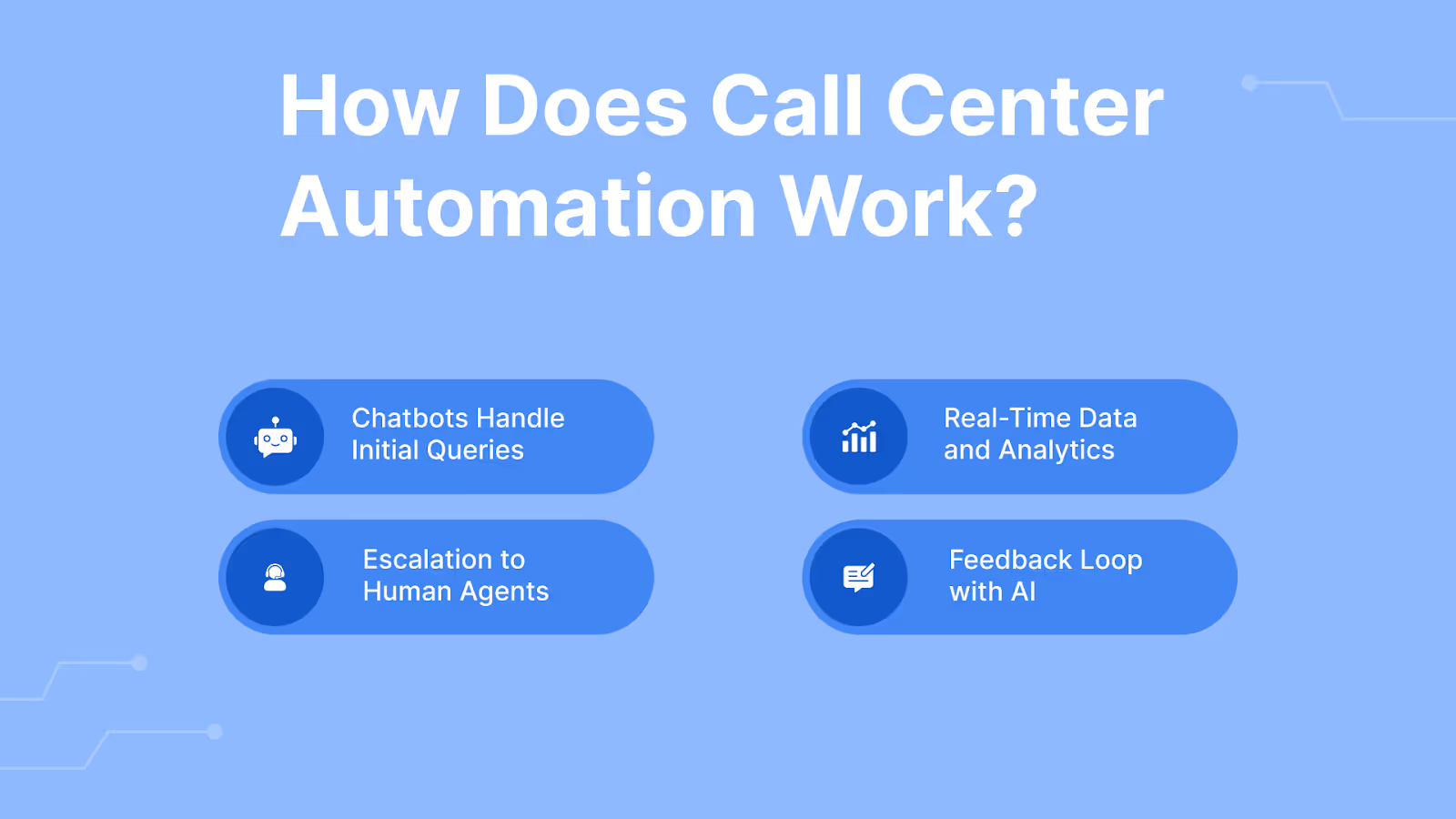
Are you curious about how all these components fit together? Call center automation operates through a seamless combination of AI, real-time data, and intelligent escalation to ensure smooth and effective service. Here's how automated calls centers work in real-world scenarios, creating an efficient experience for customers and agents.
- Chatbots Handle Initial Queries: Chatbots are the first point of contact, handling the simple stuff like account status, hours or FAQs. By automating the basics, call center automation takes the workload off human agents so they can focus on the more complex customer issues. Chatbots give instant answers, eliminating wait times for common questions.
Around 65% of call centers have implemented chatbots to manage basic customer service functions, reflecting the trend towards automating repetitive tasks.
- Escalation to Human Agents: When a chatbot or automated system cannot resolve an issue it cannot handle, the system escalates the call to a human agent. Automation call centers ensure agents get context about the customer's problem so they can jump into the conversation knowing what's happening. This seamless handoff keeps the service continuous so customers don't have to repeat themselves.
- Real-Time Data and Analytics: Call center automation tools give agents real-time information—recent purchases, past interactions, and customer sentiment. By giving agents instant access to data, automation enables them to respond better and personalize the conversation. Real-time data also lets agents anticipate customer needs and create a more responsive and informed experience.
- Feedback Loop with AI: AI in automation call centers learns from every interaction, using customer feedback and past interactions to improve future responses. This feedback loop refines responses, increases accuracy and anticipates common questions over time. The result is a better system that delivers more relevant, precise, and efficient support as it learns from customer needs.
Call center automation benefits businesses, customers, and agents alike by creating a streamlined, efficient support experience. Now, let's explore how automation can elevate satisfaction for everyone involved.
How Can Conversational AI Transform Call Centers?
Conversational AI takes automated call centers to the next level by making interactions more natural and responsive, which equals a better customer experience. With tone interpretation and multilingual support, conversational AI turns automation call centers into service hubs. Here's what conversational AI brings to the table:
- Human-Like Responses: Conversational AI can interpret tone, sentiment and context, making answers more personal and human. By understanding the mood and urgency of a customer's question, AI can tailor the reply, and the customer perceives the service as better. So, interactions in automated call centers feel more natural and less robotic and build more trust with the customer.
- Context-Aware Conversations: Conversational AI remembers previous conversations so it can pick up where you left off during follow-up calls. If a customer calls back with the same or related issue, AI agents seamlessly continue from the last conversation, saving time and boosting efficiency. This contextual awareness adds a personal touch to call center automation and makes customers feel understood and valued.
- Handling Complex Inquiries: During a call, conversational AI assists the agent with real-time suggestions and relevant information. This is especially helpful in complex cases where agents need accurate data to provide a solution. Automation call centers use AI to empower agents and give them insights into handling tricky questions smoothly and confidently.
- Enhanced Language Support: Conversational AI can support multiple languages so call center automation can reach a global customer base. Language recognition and translation capabilities let customers interact in their language, breaking down language barriers and expanding the reach of automation call centers. This ensures service quality is consistent regardless of language.
- Reduced Transfer Rates: By understanding and resolving a wide range of questions, conversational AI minimizes the need for multiple transfers. Fewer transfers mean customers get to the solution faster, are more satisfied, and are less frustrated. This streamlined approach to call center automation keeps interactions short and sweet so agents and customers can resolve issues quickly.
With conversational AI, automated call centers are evolving into proactive, customer-centric hubs that offer more than just efficient service—they deliver a personalized, engaging experience. Now, let's explore the essential steps for successfully implementing these technologies used in automated call centers.
Critical Steps to Successfully Implement Call Center Automation
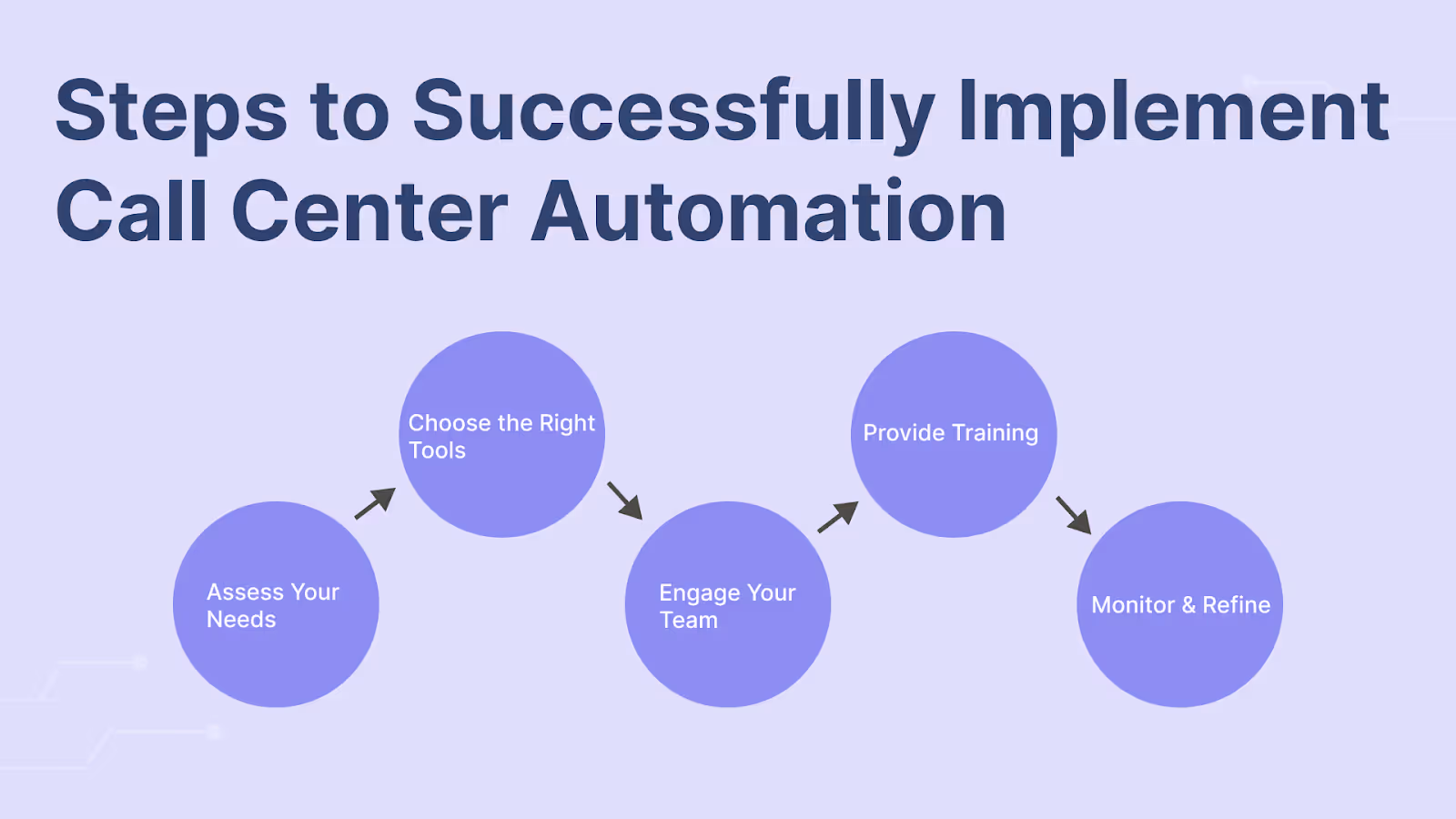
Call center automation is more than just new technology; it's a structured approach to getting it right and making it work. Here are the key steps to making automation call centers work for your business and setting the foundation for efficient and agile customer service.
- Assess Your Needs: Review your call center workflows to see which tasks can be automated and which should be human-led. Consider customer preferences and the complexity of different queries, and automate routine and repetitive tasks. This will ensure automation call centers focus automation efforts where it will have the most impact.
- Choose the Right Tools: Select call center automation software that matches your business goals and integrates with your existing systems, CRM, and communication platforms. Choose flexible, scalable tools so the software can grow with your business and add new features as needed. The right tool selection is the foundation for long-term automation call centers.
- Engage Your Team: Implementation requires buy-in from everyone involved, especially the agents who will be working alongside the automation. Involve your team in the planning and communicate the benefits of call center automation so they feel supported, not replaced. Build a collaborative environment to ease the transition and boost team morale.
- Provide Training: Give your staff the knowledge and skills to work with automation sales tools. Training will ensure agents know how to use automation call centers to streamline their workflows, increase productivity, and provide a seamless customer experience. A well-trained staff is key to getting the most out of automation.
- Monitor and Refine: Track the impact of call center automation on performance metrics like response time, customer satisfaction, and agent productivity. Use this data to make adjustments and improvements and optimize automated processes over time. Monitoring and refining will allow automated call centers to adapt to changing customer needs and business objectives.
Once you implement these steps, your automation call centers will be well-equipped to operate at peak efficiency. Let's explore some real-life examples of companies leveraging call center automation to enhance their operations and customer satisfaction.
Achieve more with less effort. Use Nurix AI virtual assistant to reduce your operational costs by 60% while maintaining top-tier service quality for every customer.
Real-Life Examples of Automated Call Centers in Action
To illustrate call center automation in practice, here are real-life examples:
1. Renewal by Andersen
Renewal by Andersen automated call grading, from manually reviewing 2% of calls to tracking them all. This improvement led to a 47% increase in customer appointments and better billing accuracy across its franchises.
2. CHRISTUS Health Plan
CHRISTUS Health Plan automated call scoring, reducing the time spent on this task by 50%. This freed up leadership to focus on training and continuous improvement, using real-time feedback to boost service quality.
3. AT&T
AT&T uses automation to efficiently handle technical support and billing inquiries, cutting operational costs and offering 24/7 support. This setup helps manage vast customer inquiries smoothly and reliably.
4. Target
Target's automation in service centers helps with order tracking, returns, and inquiries across channels. It reduces response times, providing customers with quick support while lightening the load on service teams.
With these real-world examples, automation call centers can significantly boost efficiency. But what about potential roadblocks?
Give your customers the fast, personalized support they deserve. With Nurix AI, power your call center automation and resolve queries in real-time, anytime. Get in touch with us!
Challenges and Limitations of Call Center Automation
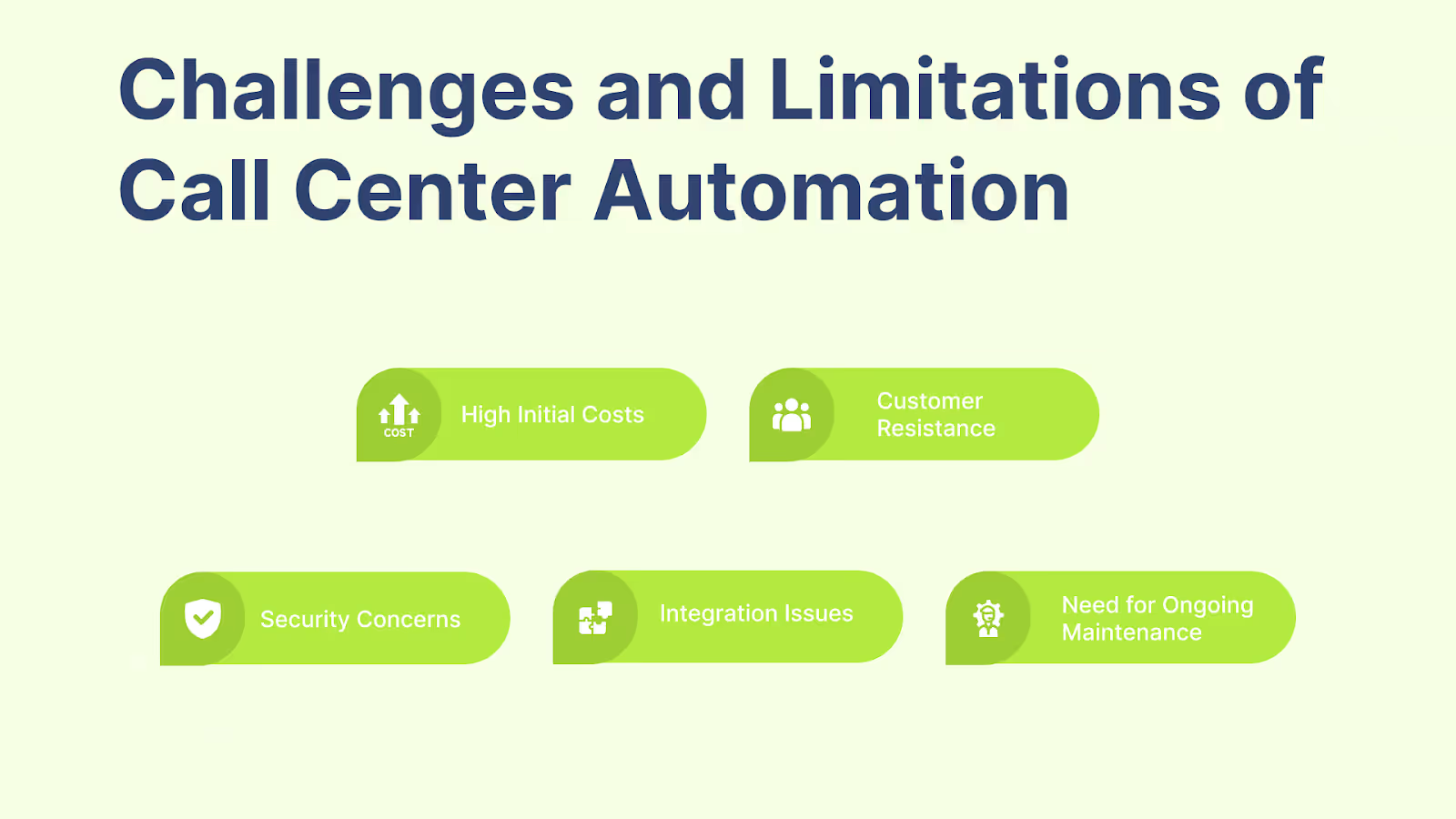
Every solution is flawed, and call center automation is no exception. While automation has many benefits, it also brings challenges that companies must overcome to make it work smoothly. Here are some of the significant challenges of automating call centers:
- High Initial Costs: Setting up call center automation can be expensive, especially for small businesses with limited budgets. Buying software, integrating systems and training staff can be costly and may delay adoption. It would help if you considered your financial readiness to support automated call centres' initial setup and ongoing costs.
- Customer Resistance: Some customers like the familiarity of human interaction, especially for complex or emotional issues. Relying too much on automated call centers can lead to frustration if customers feel they're not being heard. Addressing this resistance by offering a balance of automation and human support will help to maintain good customer relationships.
- Security Concerns: Handling customer data through automated call centers requires strict security measures to prevent data breaches. Companies must ensure their call center automation tools comply with data protection regulations, even a tiny mistake can cause substantial reputational damage. Investing in secure and compliant technology is critical to customer trust.
- Integration Issues: Not all call center automation software integrates with your existing CRM and communication platforms. Integration issues can disrupt workflows, reduce efficiency, and increase operational complexity. Choosing compatible tools and working with vendors who offer good support will help minimize these issues and ensure a smooth automation experience.
- Need for Ongoing Maintenance: Unlike static systems, automation call centers need regular updates and tuning to remain practical and relevant. Automated tools must be monitored and improved constantly to adapt to changing customer needs, emerging trends and technological advancements. This ongoing maintenance can add to the costs and operational overhead.
Understanding these challenges is essential for the successful adoption of call center automation. Addressing these limitations head-on allows businesses to optimize their use of automation technology. Now, let's explore the upcoming trends shaping the future of call center automation.
Future Trends in Call Center Automation
By 2025, it is projected that up to 95% of all customer interactions will be managed by AI systems, demonstrating a significant shift towards automation in customer service environments. Here are the trends that will shape the future of automated call centers:
- AI-Human Collaboration: Instead of replacing agents, automation will support them in a hybrid model, where AI does the efficiency and humans do the empathy. Call center automation tools will do the repetitive tasks, and agents will focus on complex, high-value interactions. This collaboration will improve service quality by leveraging the strengths of both AI and human agents and give customers efficient yet personalized experiences.
- Hyper-Personalization: Automated call centers will improve their ability to analyze customer data and deliver answers that speak to individual preferences. By leveraging insights from customer history, behavior, and preferences, hyper-personalization will increase loyalty and build stronger customer relationships. As call center automation evolves, customers will receive service that feels more relevant and intuitive.
- Real-Time Sentiment Analysis: AI can gauge customer emotions during interactions so agents can respond more emphatically and accurately. Automation call centers can deliver adaptive responses to the customer's emotional state by reading tone, language cues, and sentiment in real time. This will increase satisfaction by making customers feel heard and supported.
- Enhanced Voice Technology: Advances in voice recognition will make voice bot interactions smoother and more natural, reducing misinterpretation. Better voice technology will also allow automated call centers to handle verbal interactions more accurately, so customers will feel like they're talking to a real person. This will make voice bot interactions a more viable option for customer inquiries.
- Increased Focus on Security: As data privacy regulations tighten, call center automation will prioritize secure data handling to protect customer data. AI and automation systems will be designed with better encryption and compliance features to address potential vulnerabilities. This focus on security will help automated call centers build trust by keeping sensitive customer data safe.
These trends signal a future where automation call centers do more than streamline operations—they elevate the customer service experience to new heights.
Now, let's see how Nurix AI can elevate your call center automation with solutions that boost efficiency, customer satisfaction, and business results.
Use Nurix AI to Power Your Call Center Automation
If you're ready to leap into call center automation, Nurix AI can help with advanced tools to elevate customer service and streamline operations. Here's how Nurix AI enables automated call centers to deliver efficient, high-quality customer support:
- Task Automation: Automate routine tasks like call routing, updating customer information, processing transactions, reducing manual workload, and freeing up agents for high-value interactions.
- Real-Time Problem Solving: Nurix AI instantly identifies and resolves customer issues, ensuring faster response times and boosting customer satisfaction by 36%.
- Omnichannel Support: Through seamless integration, deliver consistent, high-quality service across multiple platforms (chat, phone, email, social media), allowing agents to manage customer queries efficiently from a unified interface.
- 24/7 Availability: With Nurix AI, your call center operates round the clock, ensuring customers receive support anytime without waiting for business hours.
- Personalized Interactions: Tailor responses and actions based on customer profiles, providing a more personalized experience that drives engagement and loyalty.
- Cost Efficiency: Reduce the cost per ticket by 60% with Nurix AI's automation while maintaining exceptional service quality and improving overall operational efficiency.
- Increased Agent Productivity: By automating repetitive tasks, Nurix AI allows agents to focus on complex queries and high-value tasks, tripling productivity and improving customer outcomes.
Ready to elevate your call center experience? With Nurix AI agent, you gain a trusted partner in delivering efficient, customer-centred automation solutions that drive satisfaction, loyalty, and operational success.
Conclusion
Call center automation has moved from being an optional upgrade to an essential part of modern customer service. With the advancements in AI, NLP, and RPA, automation call centers are poised to offer faster, more accurate, and more satisfying customer interactions. As we look toward the future, the call center industry will continue to evolve, balancing AI-driven solutions with human insight to create a service experience like never before.
Instantly solve customer queries with Nurix AI’s Real-Time Problem Solving. Reduce turnaround time by 80% and deliver faster, more efficient service with every interaction. Talk to us!
Call Center Automation FAQs
To cover the technical details, here are answers to some of the most frequently asked questions about automated call centers. These insights clarify how call center automation works, its benefits, and how it impacts customer service operations.
- What are the future possibilities for call center automation?
The future looks bright for call center automation, with AI and advanced analytics being integrated to make service more efficient. Emerging trends like AI-human collaboration, hyper-personalization, and real-time sentiment analysis are changing how automated call centers work. As technology evolves, automated call centers will become more intelligent and better for customers and agents.
- How does automation improve customer service in call centers?
Call center automation improves customer service by handling the mundane quickly, reducing wait times and ensuring consistency in answers. Automated systems like chatbots and IVR provide instant answers and let agents focus on complex issues. This task division creates a smoother customer experience and better overall satisfaction with faster and more reliable support.
- What are the standard technologies used in automated call centers?
Automated call centers use chatbots, Interactive Voice Response (IVR) systems, Automatic Call Distribution (ACD), Computer Telephony Integration (CTI), and AI-powered tools for real-time analytics, sentiment analysis, and predictive dialing. These technologies used in automated call centers work together to make operations more efficient and improve customer interaction.
- How does AI and machine learning contribute to call center automation?
AI and machine learning bring intelligence to call center automation by allowing systems to learn from past interactions and improve answers over time. Machine learning algorithms analyze data to predict customer needs, provide real-time insights, and provide hyper-personalized answers. This integration makes automated call centers more agile and responsive to changing customer demands.
- Can automation call centers reduce the need for human agents?
While automation can handle many tasks, human agents need more. Automation is most effective when used to manage the mundane and let agents focus on high-value complex interactions. This balance ensures that automated call centers can deliver efficient service and still provide a human touch for situations that require empathy and personalized care.
- How can businesses measure the success of call center automation?
Measure call center automation by tracking customer satisfaction, average handle time, call resolution rates and agent productivity. Real-time analytics also gives you insight into customer behavior and engagement so you can gauge the effectiveness of automation. These metrics will tell you if automation call centers meet your goals and deliver a better customer experience.

